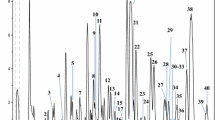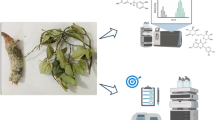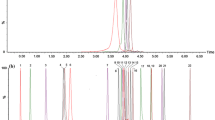Abstract
In the present study, a method based on liquid chromatography with diode array detection (HPLC-DAD) coupled to an electrospray ionisation (ESI) interface was developed for the determination of the constituents in the aqueous preparations of Viola odorata L. flowering tops. The developed assay was fast, simple and effective and permitted the quality control of the preparations. The aim of this work was to assess the qualitative and quantitative profile of the investigated preparations, which find until today wide applications in food and cosmetic industry, and to propose a validated method for their quality control. Characteristic constituents of V. odorata flowers are considered to be the anthocyanins; however, a detailed literature research showed that data concerning their chemical content are scarce. HPLC-DAD-ESI-MS analyses supported by extensive preparative chromatographic investigations and 2D NMR analyses revealed the predominance of complex flavonol glycosides and permitted the complete characterisation of the content of V. odorata preparations. This is the first report of detailed analysis of the chemical composition of V. odorata flowers.



Similar content being viewed by others
References
Germplasm Resources Information Network (GRIN), United States Department of Agriculture, Agricultural Research Service, Beltsville Area. http://www.ars-grin.gov/cgi-bin/npgs/html/taxon.pl?41733
BHMA, British Herbal Medicine Association, British Herbal Compedium (2006) Bradley P (ed) Bournemouth, Vol. 2, pp 381–384
Svangård E, Burman R, Gunasekera S, Lövborg H, Gullbo J, Göransson U (2007) J Nat Prod 70:643–647
ESCOP Monographs, Supplement (2009) The European Scientific Cooperative on Phytotherapy, 2nd edn. Thieme Verlag, Stuttgart, pp 280–283
Bilia AR, Eterno F, Bergonzi MC, Mazzi G, Vincieri FF (2007) J Pharm Biomed Anal 44:70–78
Karioti A, Bolognesi L, Vincieri FF, Bilia AR (2010) J Pharm Biomed Anal 53:15–23
Bilia AR, Giomi M, Innocenti M, Gallori S, Vincieri FF (2008) J Pharm Biomed Anal 48:463–470
Bilia AR, Fumarola M, Gallori S, Mazzi G, Vincieri FF (2000) J Agric Food Chem 48:4734–4738
Leite JPV, Rastrelli L, Romussi G, Oliveira AB, Vilegas JHY, Vilegas W, Pizza C (2001) J Agric Food Chem 49:3796–3801
Vermes B, Farkas L, Nógrádi M, Wagner H, Dirscherl R (1976) Phytochemistry 15:1320–1321
Kite GC, Stoneham CA, Veitch NC (2007) Phytochemistry 68:1407–1416
Wagner H, Bladt S, Zgainski EM (1984) Plant drug analysis. Springer, Berlin
Strack D, Wray V (1989) In: Dey PM and Harborn JB (eds) Methods in Plant Biochemistry Academic Press, London, San Diego, New York, Berkeley, Boston, Sydney, Tokyo, Toronto, pp. 330–331
Drozdova IL, Bubenchikov RA (2005) Pharm Chem J 39:197–200
Vukics V, Ringer T, Kery A, Bonn GK, Guttman A (2008) J Chromatogr A 1206:11–20
Carnat AP, Carnat A, Fraisse D, Lamaison JL (1998) J Nat Prod 61:272–274
Vukics V, Kery A, Bonn GK, Guttman A (2008) Anal Bioanal Chem 390:1917–1925
Flamini G (2007) Chem Biodiv 4:139–144
Acknowledgements
The authors would like to thank Dr. Sandra Gallori for the technical assistance with the chromatographic HPLC analyses.
Author information
Authors and Affiliations
Corresponding author
Electronic supplementary material
Below is the link to the electronic supplementary material.
ESM 1
(PDF 910 kb)
Rights and permissions
About this article
Cite this article
Karioti, A., Furlan, C., Vincieri, F.F. et al. Analysis of the constituents and quality control of Viola odorata aqueous preparations by HPLC-DAD and HPLC-ESI-MS. Anal Bioanal Chem 399, 1715–1723 (2011). https://doi.org/10.1007/s00216-010-4473-2
Received:
Revised:
Accepted:
Published:
Issue Date:
DOI: https://doi.org/10.1007/s00216-010-4473-2




